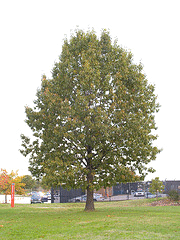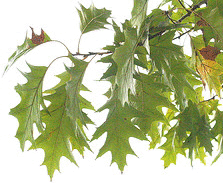Northern Red Oak Trees
Red Oak is also known as Northern Red Oak or Champion Oak
Quercus rubra (syn. Quercus borealis) Northern Red Oak
Zones: 3-8
Full Sun
Height: 60-75’
Spread: 50-60’
Shape: Rounded
Growth Rate: Moderate
Soil Preference: Prefers sandy or loam acid soil but will also grow in clay. Moderate tolerance to soil salt. Will develop chlorosis in high pH soils.
Moisture: Average moisture requirements, is somewhat drought tolerant.
Foliage: Leaves open reddish in spring, turning dark green in summer.
Blooms: Pale yellow-green catkins in spring
Fruit: Acorn
Although often referred to as simply Red Oak, It is formerly named Northern Red Oak to be distinguished from the Southern Red Oak, also known as Spanish Oak. Northern Red Oak is native to the midwest and Canada, but grows well in a much larger area, nearly all of the United States. It is very urban and pollution tolerant, making it an excellent street tree. And the wood has superior strength, making damage from wind, ice and storms less likely than many other trees. It is easy to transplant as it does not grow a tap root. A Northern Red Oak will attract all kinds of wildlife. The acorns of the Red Oak are highly desired by bluejays, squirrels, white tailed deer, racoons and black bears. The deer, however, may also browse the twigs and buds of the Red Oak. Northern Red Oak is a fast growing tree reaching 15’ in just 10 years. As the tree matures, the bark develops silvery stripes up and down the trunk. Branches are massive and ascending, and tend to grow low to the ground. Lower branches may be pruned off for clearance. Foliage is brilliantly colored with russet brown, russet red and bright red. The Northern Red Oak is an excellent choice as a shade tree, specimen tree or street tree due to it’s easy adaptability.


